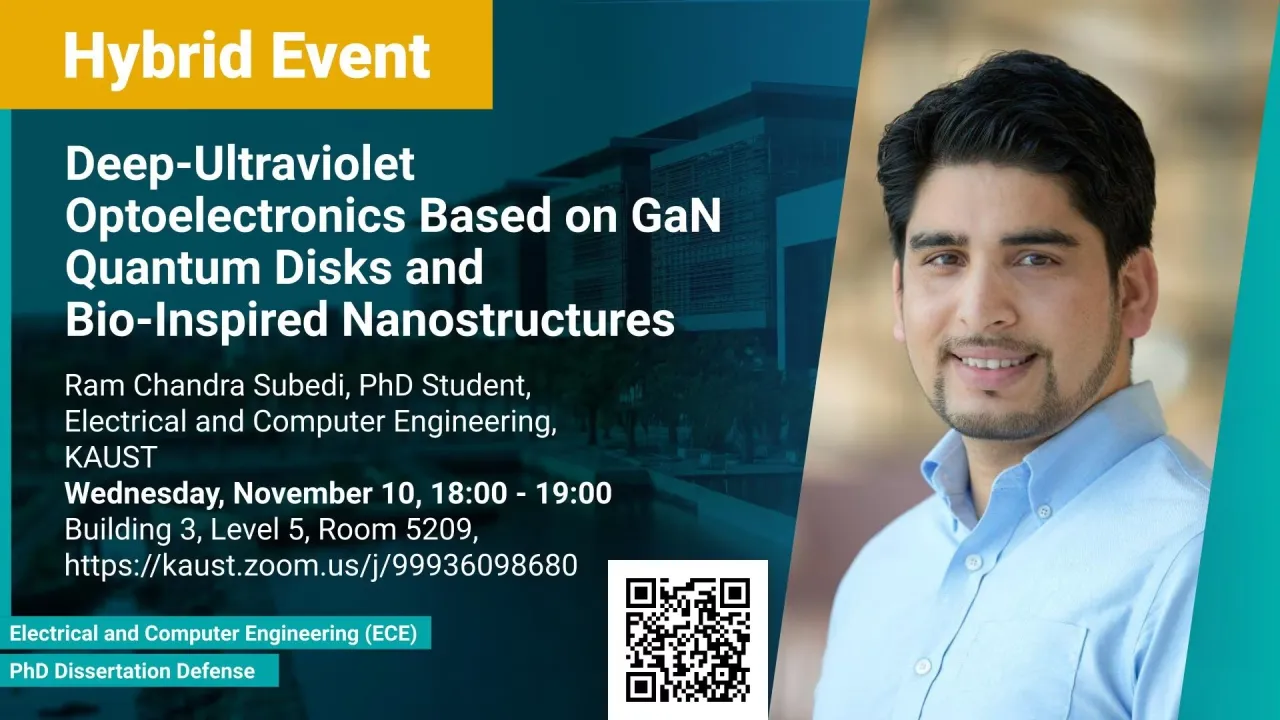
Deep-Ultraviolet Optoelectronics Based on GaN Quantum Disks and Bio-Inspired Nanostructures
Optoelectronics in the deep-ultraviolet (DUV) regime is still a growing research field that requires significant effort to understand the material properties and optimize the device structures to realize highly efficient DUV devices. Of all the wide bandgap materials, AlGaN is perhaps the most studied semiconductor to replace the environmentally hazardous mercury lamps; however, the external quantum efficiency (EQE) of AlGaN based DUV devices is insufficient to replace the existing old-fashioned mercury UV lamps.
Overview
Abstract
Optoelectronics in the deep-ultraviolet (DUV) regime is still a growing research field that requires significant effort to understand the material properties and optimize the device structures to realize highly efficient DUV devices. Of all the wide bandgap materials, AlGaN is perhaps the most studied semiconductor to replace the environmentally hazardous mercury lamps; however, the external quantum efficiency (EQE) of AlGaN based DUV devices is insufficient to replace the existing old-fashioned mercury UV lamps. Despite the tunability in the bandgap of AlGaN, the excessive strain accumulation associated with increased alloying of Al in AlGaN and the poor dopant activation due to the relatively large ionization energy of the donors and acceptors are not favorable for realizing efficient deep-UV emitters. In addition, the crossover among the light hole, heavy hole and split-off bands in the valance band for Al-rich AlGaN suppresses the transverse-electric (TE) polarization which further worsens the external quantum efficiency. Furthermore, for deep-UV photodetection, commercially available Si-photodetectors suffer from poor responsivity for wavelengths shorter than 400 nm. Hence, the-state-of-art photodetectors in the DUV regime also need a significant upgrade, particularly for high-speed applications.
Firstly, we utilized the high quantum confinement in plasma-assisted MBE grown ultrathin GaN QDisks to realize deep UV (~ 260 nm) emission using a binary compound (GaN) in contrast to conventionally used ternary compound (AlGaN). More importantly, we experimentally demonstrated two orders of magnitude higher TE mode when compared to the transverse-magnetic (TM) mode, unlike Al-rich AlGaN, illustrating a unique pathway for realizing efficient deep-UV vertical emitters. Secondly, inspired by the light manipulation technique practiced in nature, we presented iridocytes on giant clams (Tridacna maxima), known for their symbiotic relationship with algae as a color downconverting material for deep UV photodetection. Investigating the structural and optical properties of iridocytes found in Tridacna maxima, we established a robust UV communication allowing the data transfer rate of 100 Mbit/s within the forward error correction (FEC) limit for 375 nm. Using a similar matrix implemented to 375 nm laser, with high-power UV-C LED (278 nm), we could establish an optical wireless communication (OWC) that could allow a data-transmission rate of tens of Mbit/s within the FEC limit.
Brief Biography
Ram Chandra Subedi is a Ph.D. student in the Photonics Laboratory at King Abdullah University of Science and Technology in Electrical Engineering. He received his MS (Physics) degree from the University of Georgia, the USA, in 2016. Also, he holds MSc (Physics) and BSc (Physics with Statistics minor) degrees from Tribhuvan University, Nepal, in 2011 and 2007, respectively. His current research focus is on deep UV optoelectronic based on III-nitride nanostructures and biophotonic materials. He has co-authored over 30 publications in peer-reviewed journals and conferences. Also, he has been actively serving as a peer reviewer for manuscripts submitted to Optica (formerly OSA), ACS, IOP, APS, Wiley, De Gruyter, Frontiers, etc., considered for leading journals in the field of optoelectronic materials and devices, including Physical Review Letters, Optica, ACS Applied Electronic Materials, Optics Express, Optics Letters, Nanophotonics, and Optical Material Express.
